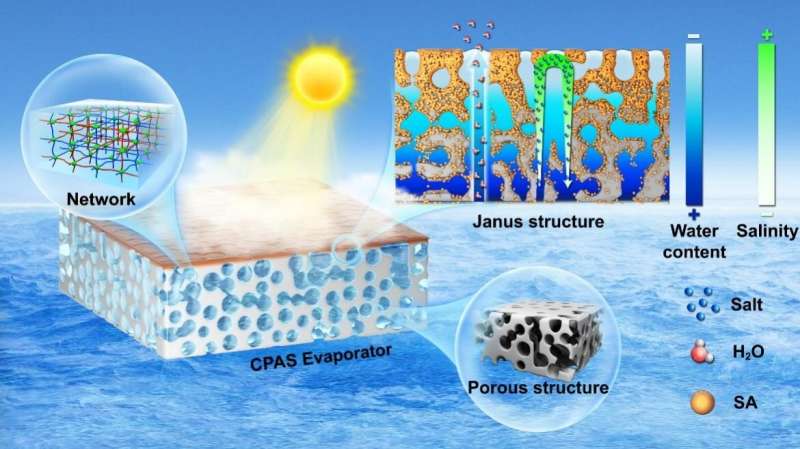This article has been reviewed according to Science X's editorial process and policies. Editors have highlighted the following attributes while ensuring the content's credibility:
fact-checked
proofread
High efficiency, salt resistance and high strength desalination achieved with new hydrogel solar evaporator

In the face of increasing global scarcity of freshwater resources, desalination is considered one of the most effective ways to alleviate this problem. However, it does come with a catch—efficient and low-cost evaporation materials are key to achieving large-scale applications.
Hydrogels present a promising opportunity, yet conventional uses of these in interfacial solar evaporators still lack the ability to satisfy the trade-off for high evaporation rate, salt resistance and durable mechanical properties.
Therefore, most traditional hydrogel materials are only suitable for low-salinity brine, far from the requirements of long-term evaporation and treatment of industrial high-salinity wastewater. It has been demonstrated that the salt resistance of hydrogels can be enhanced by constructing interpenetrating 3D macropore structure.
Nonetheless, rapid water transport and high water content can lead to increased conductive heat loss. This problem can be solved by further designing the Janus structure. Furthermore, although various methods for creating such structures exist, they are often complex and lack surface stability.
To that end, a team of researchers from the School of Chemical Engineering and Technology at Hebei University of Technology in Tianjin, China, introduced hydrophobic fumed nano-silica aerogel (SA) into the hydrogel production process. The ultra-lightweight and super-hydrophobic properties of SA enable it to spontaneously migrate and aggregate to the upper region of the hydrogel during the gelation process, forming a Janus structure.
"We know that the regulation of pore structure can also balance the problem of increased heat loss caused by the high salt resistance of the sponge-like hydrogel," explained Aqiang Chu, lead author of the study published in Green Energy & Environment. "Consequently, we incorporated agar (AG) to enhance the comprehensive performance of hydrogel evaporators."
Notably, AG has a thickening function, which in this case stabilizes the bubble structure formed during the foaming process, and thus help regulate the pore structure of the hydrogel.
"The large number of hydroxyl groups on the AG chain can at once reduce the enthalpy of water evaporation by interacting with water and forming ether bonds with polyvinyl alcohol to form a robust cross-linked network, contributing to improved mechanical properties," Chu explained further.
"Coupled with the low cost and environmental friendliness of these preparation materials, our Janus dual-network sponge-like hydrogel solar evaporator shows great potential for practical applications in the field of interfacial solar evaporation," added corresponding author Hao Li.
More information: Aqiang Chu et al, Biomass-enhanced Janus sponge-like hydrogel with salt resistance and high strength for efficient solar desalination, Green Energy & Environment (2023). DOI: 10.1016/j.gee.2023.04.003
Provided by KeAi Communications Co.





















